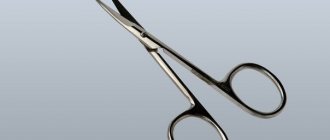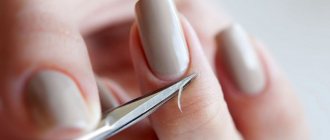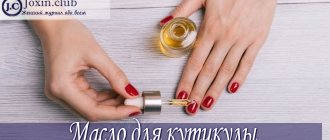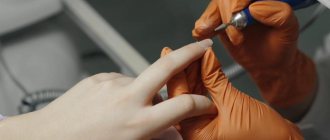Where does a quality manicure begin? Is it quality, and not just beautiful? No, not with good varnish and not with trendy design. Spectacular form has nothing to do with it either. A high-quality manicure, first of all, means well-groomed hands and nails. Well-groomed nails are neat plates, even without varnish, but always with a beautiful line of skin around the nail bed. This is a thin moisturized cuticle without burrs, side ridges without calluses. To achieve a similar effect, you need regular hygienic manicures with mandatory cuticle treatment.
Photo from the site: odnatakaya.ru
There are several ways to remove cuticles, and today we will talk about the latest know-how in the field of nail care - removing cuticles using a remover.
Remover functions
Women who are accustomed to doing their own manicure will be especially interested in the information below. Nail ridges and cuticles can be removed in two ways - mechanical (trimmed manicure) and chemical, which involves the use of a remover.
A highly qualified craftsman can carefully remove dead skin using tools without risk to health. Therefore, it is easier to do an unedged (English) manicure at home.
The procedure involves the use of a remover and an orange stick, which is commonly called a pusher. Although, this device can be made of any material.
Remover is a drug containing substances that act on dead skin. However, they are not able to have a negative effect on living epithelium. This method of performing a manicure is an excellent solution for women whose skin on their hands is delicate, sensitive and thin. Vessels located too close to the surface can also be a serious problem for the master. This circumstance makes it impossible to use tools.
How it works
When applied, the stratum corneum dissolves. Thanks to this effect, the cuticle is easily removed with a pusher. If the product is chosen incorrectly and used incorrectly, it can cause a chemical burn. The advantages of removers include:
- Can be used on sensitive hand skin.
- No chance of infection.
- Simplicity and convenience.
- Accelerated treatment of the periungual space and cuticle.
- No burrs.
- Slow regrowth, which is especially noticeable with regular use of the remover.
How does cuticle remover work?
Remover is a potent agent that eats away dead skin particles. Initially, such preparations were used to remove artificial nails and gel polishes. The active components contained in removers are able to dissolve the polymers of gel polishes and extended nails, and therefore the latter come away from the natural nail much more easily.
As soon as manicurists noticed this pattern, they began using removers to treat calluses and to remove rough areas of the cuticle. Naturally, manufacturers produce more gentle formulations for the skin. They will not damage sensitive skin.

The principle of operation of the remover is simple: the product is applied to dead skin areas, the active substances contained in the preparation gently break them down, so you can easily remove dead particles using wooden manicure sticks or a scraper.
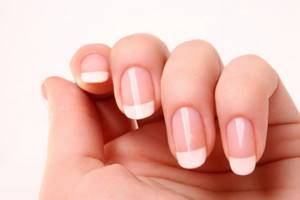
Types of removers
Sometimes removers are mistakenly called keratolytics. This is incorrect, since a remover is a remedy, and a keratolytic is a substance included in its composition. The task of a keratolytic is to quickly and safely exfoliate dead cells from the skin. By their nature, keratolytics are:
- Alkaline. They have a gentle effect on fabric. As a rule, a remover with an alkaline keratolytic is not classified as an immediate remover. NaOH or KOH acts as a keratolytic.
- Acidic. Professionals prefer to use such removers. Cuticle dissolution time is 2 minutes. The use of such products requires compliance with safety precautions. Any mistake is fraught with the appearance of itching, allergies, redness and gradual thinning of the nail plate. The function of a keratolytic is performed by a water-soluble acid or a complex thereof. These are glycolic, lactic, citric acid, etc.
- Urea. The active ingredient is urea. Urea keratolytics are considered the most modern and safe. They are recommended for use by people who have any health problems (vascular diseases, diabetes, etc.). 10% drugs are classified as universal, 10-20% are designed for professionals. Products containing 20-30% urea are intended for pedicures in “severe cases”.
- Mineral. They are rare. They're not cheap. But they have a double effect: they remove the cuticle and nourish the nails with minerals. The composition contains auxiliary components: sea water, magnesium, calcium, silicon, zinc.
- Oily. Suitable for beginners. Oil by itself does not dissolve anything. It just makes the cuticle skin softer, which makes it easy to push it away with a pusher.
Difference Between AHA and BHA
The chemical term α-Hydroxy acids is unclear to many. These are alpha-hydroxy acids, which are part of removers designed to remove cuticles. They are moderately aggressive (lemon, milk, glycolic). Their task is reduced to deep penetration into the skin in order to destroy the bonds between “living” and “dead” cells.
For a pronounced effect, which is required in “advanced cases” or when performing a pedicure, it is more appropriate to use removers containing β-Hydroxy acids. These are beta-hydroxy acids (azelaic, phytic, salicylic, etc.), which have an intense effect on dead skin cells.
Classification by texture
Creamy, liquid and gel-like removers are available on sale. Each type has advantages and disadvantages. For example, liquid may flow under the nail bed, causing it to soften.
Creamy removers are more convenient as they do not spread, but they need to be rubbed in thoroughly. Of these, the gel is more preferable, but it matters which substance performs the keratolytic function.
Design options
The finishing touch to any manicure is the application of nail polish to highlight a unique look, and a combo manicure is no exception. This technique does not imply restrictions in the choice of shades or patterns, so you can use absolutely any ideas. However, there are several unspoken rules that help you choose a win-win design or avoid common mistakes.
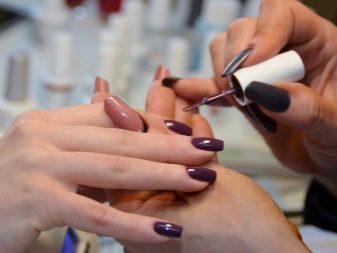
Small nails should not be overloaded with large prints with a lot of details, as this makes the nail plate of the little finger look smaller. In this case, a single-color varnish (with sparkles) or a relatively small, simple pattern will look much better. A good solution is to highlight one of the fingers (usually the ring finger is used for this) - use all solid colored nails in a colored pattern or with some design on each hand.
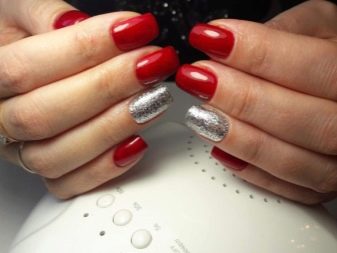
Traditionally, nail art is more glossy than matte, but the latter is not only not pretentious, but also very elegant - while always appropriate and never considered provocative. An added benefit is that it's inconspicuous and one of the easiest ways to stand out without being overly pretentious. Another unusual option is to use two polishes of the same color on each nail, one glossy and the other matte. This type of work requires considerable skill, and the owner must have experience and a steady hand, but the best examples result in an effect that provides a mesmerizing texture to the nails.

As for more complex designs, they are usually only suitable for long nails. The client herself will choose the image to her liking, but it is worth remembering that in this case the nails will become another mirror of the soul. For this reason, it makes sense to choose an image that is somehow connected with the girl’s life.
Selection rules
When choosing a remover, you should take into account the likelihood of allergic reactions to the “chemicals”. Financial capabilities and skin sensitivity threshold are taken into account. If a person plans to use a remover for the first time, then preference should be given to a drug with a mild effect. It is possible that it will be an oil remover.
If you intend to perform a pedicure, then “oil” will not work, since the skin on the feet is rougher than on the hands. It is recommended to use an alkaline remover. The option of using an acid remover should only be considered if you have experience. When choosing a chemical cuticle remover, you should always pay attention to the expiration date and information indicated on the packaging.
The gel-like preparation, enclosed in a jar with a special shape, is easy to use. The presence of an elongated dispenser spout is an obvious advantage. The option with a brush is also not bad, and it is considered economical, since applying the product with a brush minimizes the likelihood of overuse.
Using removers
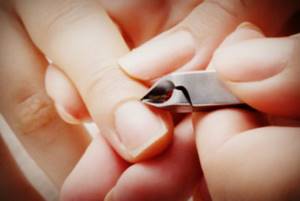
Combi-technique (classic edged manicure + remover)
- Remove the coating from your nails and give them the desired shape.
- Using a pusher, push the skin around the perimeter of the nail.
- Apply remover.
- Leave the product for the required amount of time.
- If a wet technique is used, the remover is washed off with plain water. If it is dry, then wipe the treated area with a cotton pad moistened with micellar water.
- Lift and remove any remaining softened skin using a pusher.
- Trim the raised cuticle with scissors or tweezers.
- Treat the nail plates with a dehydrator and primer, and the skin around them with oil or care product.
Unedged (European) manicure
It has another name - acidic. The technique may involve both “soaking” your hands and performing a European manicure “dry”. If preference is given to the option without soaking, then the algorithm of actions is as follows:
- Remove the coating from your nails using any method.
- To move the thin skin, you can use a pusher made of metal, plastic or wood.
- Treat problem areas with remover. Wait for him to react.
- Remove cuticle.
- Treat the nail plates with oil or a special cosmetic.
If after this procedure it is planned to perform nail extensions or coating, then the remnants of the product containing keratolytics are eliminated with water. Next, the nails are treated with a degreaser and primer. “Wet” European manicure involves soaking your hands in water with a remover already applied. This is necessary for more intense softening.
Removing gel polish with remover
To remove shellac with a product that is not entirely intended for this purpose, you need to perform the following steps:
- Generously lubricate the skin around the nail plates with rich cream.
- Moisten a cotton pad with remover and apply to the nail plate. This procedure must be performed on each nail.
- Wrap each finger in foil (to prevent product evaporation).
- Remove cotton pads after 15 minutes.
- Remove any remaining coating using a pusher.
Stages of the procedure
The tattoo removal procedure is carried out in a salon. It’s worth starting your preparations in advance. For a week, you should stop drinking alcohol and strong coffee. It is also recommended to take a course of herpes prevention so that there are no rashes after the procedure.
Stages of the procedure:
- the skin is cleansed and treated with an antiseptic;
- the process of introducing a remover resembles the process of performing tattooing, the substance is introduced exactly to the same depth as the pigment, otherwise it will not remove the dye or will only partially remove it;
- After introducing the remover, a soothing cream is applied to the skin.
In most cases, a repeat procedure is required to completely remove the tattoo.
Alternative to remover
If it is not possible to purchase a professional cuticle remover, then ordinary soda and salt baths can be an alternative. To prepare a soda solution you will need:
- liter of hot water;
- baking soda – 2 tsp.
For optimal effect, you can add a few drops of liquid soap to the solution. Keep your hands in the solution for 10 minutes. Of course, it will not dissolve the cuticle, but it will make it more pliable. The steamed peel can be easily moved with an orange stick and cut off with tweezers. Soda can be replaced with sea salt, and it is recommended to use lemon juice and any essential oil as auxiliary components. These ingredients are added to the solution in an amount of 5-7 drops.
Allergy to removers
An allergic reaction is provoked by substances included in the composition of the products. The most problematic in this regard are removers with alkaline keratolytics. If alkali is introduced into the composition in high concentration, then people with hypersensitivity may experience allergies.
It is accompanied by the appearance of watery blisters, redness of the skin, and tingling. These are signs of a chemical microburn. When choosing a drug, your skin type must be taken into account. And if it is dry, then it is undesirable to use an alkaline remover.
The best liquid removers
Sally Hansen Instant Cuticle Remover Gel 29.5 ml
This product softens the cuticle instantly, and it only takes 15 seconds! Despite the small volume of the bottle, the drug will last for a long time, because it is presented in a gel format and has convenient packaging that eliminates overuse.
Contains chamomile and aloe extracts. The manufacturer recommends using a remover to remove calluses. In this case, the exposure time should not exceed 1 minute.
OXXI Cuticle Remover cuticle remover, 50 ml
The product is intended for removing cuticles. With regular use, the drug slows down its growth. It has a mild exfoliating effect and does not have a negative effect on “living” tissues.
Areas with keratinized skin are subject to treatment with remover. The minimum exposure time is 15 seconds. The drug is suitable for home and independent use.
Cuticle remover CND Cuticle Away, 177 ml
Professional product for removing dead skin cells and cuticles. It can be used to solve a wide range of problems. It contains 20% alkali, which has an intense effect on problem areas.
The drying effect of alkali is neutralized due to the presence of aloe extract in the composition. The remover has a gel-like texture and a convenient dispenser shape, which makes it easy to use.
Reviews
Marina, 32 years old: “I do manicures myself. I used to use manicure tools, but gradually abandoned them because removers are easy to use. I give preference to products manufactured under the SEVERINA brand. I chose “Cuticle Remover Gel with Vitamin E.” In principle, it suits me, because this remover not only softens the cuticle, but also nourishes and moisturizes the skin around the nail.”
Inna: “I am a manicurist, so I know a lot about removers. I do not use the same drug, because each of my clients requires an individual approach to their hands and feet. For example, sometimes I use a pencil impregnated with a special compound called “anticuticle”. To solve my professional problems, I use proven products: Cuticle Away CND, Avoplex from OPI, SOPHIN (gel or pencil).”
Care and recovery period
Care and recovery period is an important point that must be discussed with the master. After a few hours, a dense crust forms on the treated surface, which under no circumstances should be torn off. The crust will separate on its own in 7-14 days, it depends on individual characteristics.

Before peeling off the crust, it is not recommended to wet the treated area or rub it with a towel. You can only lightly blot the skin with a damp cloth. Cosmetics in the treated area can be used in about a month. Before going outside, you need to apply sunscreen to your skin.




